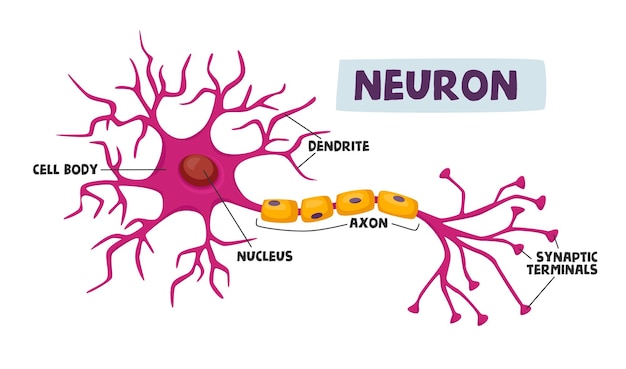

There is a small gap between two synapsed neurons, where neurotransmitters are released from one neuron to pass the signal to the next neuron. Synapses: Dendrites receive signals from other neurons at specialized junctions called synapses.Dendrites can have small protrusions called dendritic spines, which further increase surface area for possible connections with other neurons. Some types of neurons do not have any dendrites, some types of neurons have multiple dendrites. Dendrites: are tree-like structures that extend away from the cell body to receive neurotransmitters from other neurons.Neurons also contain unique structures, dendrites and axons, for receiving and sending the electrical signals that make neuronal communication possible: Like other cells, each neuron has a cell body (or soma) that contains a nucleus and other cellular components. Neurotransmitters are chemical messengers which are released from one neuron as a result of an action potential they cause a rapid, temporary change in the membrane potential of the adjacent neuron to initiate an action potential in that neuron. An action potential is a rapid, temporary change in membrane potential (electrical charge), and it is caused by sodium rushing to a neuron and potassium rushing out. The electrical signals are action potentials, which transmit the information from one of a neuron to the other the chemical signals are neurotransmitters, which transmit the information from one neuron to the next. Neurons communicate via both electrical signals and chemical signals. Recent evidence suggests that glia may also assist in some of the signaling functions of neurons. Glia can be compared to the workers at the electric company who make sure wires go to the right places, maintain the wires, and take down wires that are broken. A neuron can be compared to an electrical wire: it transmits a signal from one place to another.
#AXON DENDRITE FOR FREE#
All Khan Academy content is available for free at The nervous system is made up of neurons, the specialized cells that can receive and transmit chemical or electrical signals, and glia, the cells that provide support functions for the neurons. The information below was adapted from OpenStax Biology 35.1 and Khan Academy AP Biology The neuron and nervous system. Describe the structure and function of neuronal synapses and the role of neurotransmitters at the synapse.Interpret an action potential graph and explain the molecular mechanisms underlying each step of the action potential.Describe the structure and function of neurons.


 0 kommentar(er)
0 kommentar(er)
